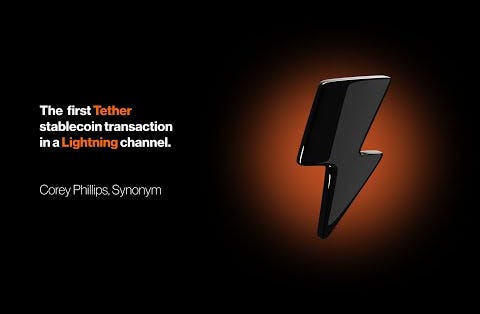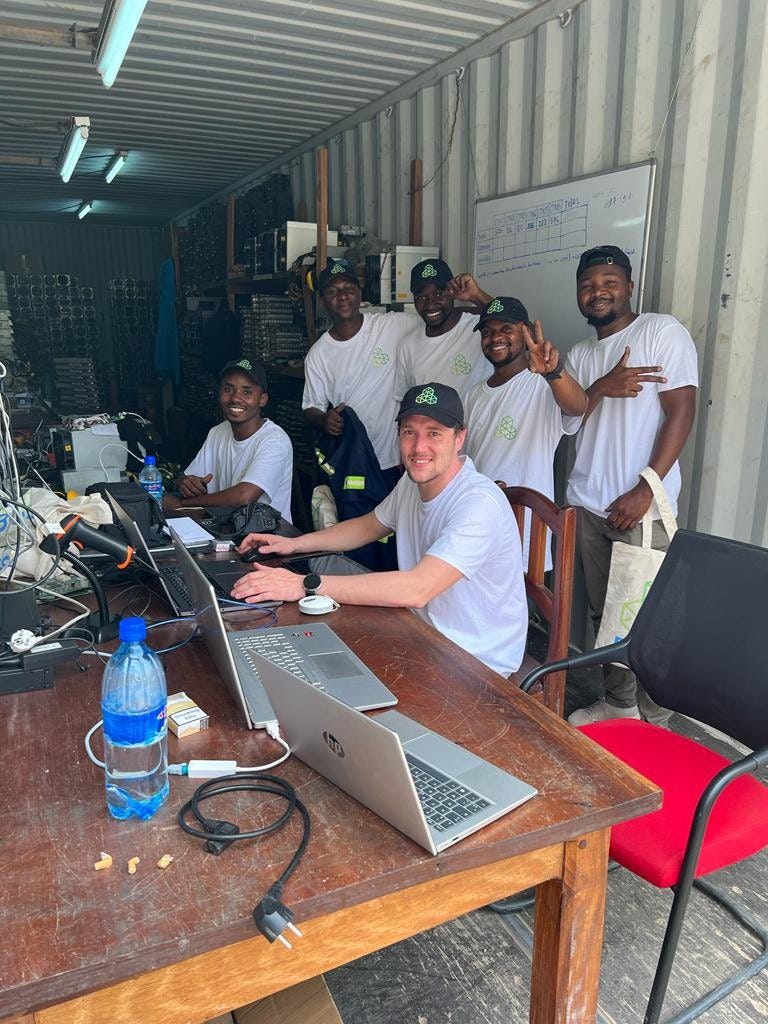#45 - Special Bitcoin Mining issue, Gamified Trading, and much more!
⛏️ Bitcoin Mining: facts on the ground with Sébastien Gouspillou
We like to call Sébastien Gouspillou the Indiana Jones of Bitcoin. He has set up mining facilities all around the world (in Central America, Central Africa, Central Asia, UAE, etc.), on top of being a great advocate for the industry in Europe.
He has been working between Europe and Asia since 2014 for the green agro-forestry industry. Active promoter of the triple bottom line, he quickly perceived Bitcoin’s possible very strong societal impact. He then created several companies destined to serve what could be the lever of a huge social progress : the Bitcoin protocol. He is currently launching BBGS, which aims to catch up with the exponential demand for renewable-focused Bitcoin mining infrastructure around the world.
Bitcoin consensus algorithm Proof-of-Work and its energy consumption seem to be a very sensitive and controversial topic these days. Thank you Sébastien for sharing facts from your mining experience on the ground 🙏
The “Bitcoin mining is burning the planet” narrative seems powerful to scare people away from it. What are your counter-arguments?
Sébastien Gouspillou: There are no facts to back this narrative, it is therefore difficult to have counter-arguments. This narrative comes from people who do not understand the interest of BTC, or who refute its usefulness. Hence, for them, each KWh absorbed by mining is one KWh too much obviously.
However, here are a few figures to counter this narrative:
- 60% of the mining is made with extra renewable capacities (electricity that cannot be sold to anyone else)
- The increase in the price of hydrocarbons will increase this figure to 80% in 2022
- Mining is the customer of last resort for renewables. It is becoming an essential economic factor for any renewable electricity development project.

Can Bitcoin mining activity affect the local population, increasing energy prices for them?
Sébastien Gouspillou: No. To understand this, I copy here part of my report to the Salvadoran authorities of March 9th, 2022:
“Bitcoin mining must be socially useful. It must not compete with traditional demand, ever. It must be set up where there is an extra capacity in order to optimize the installed capacity/consumption ratio.
Organised in this way, mining becomes a blessing for a country. Otherwise, it can quickly become a threat to the supply of the population and can create a kind of chaotic situation. It therefore seems that mining must absolutely be supervised by the state, both for the comfort of the population and for the reputation of bitcoin and its exploitation. For us, the ideal model should be a win-win situation for both the private miners and the country; so far, that has never quite been the case. […]
In order to respect the fundamental rule of non-competition with the population, the miner must agree to stop his activity immediately in the event of an unexpected peak of demand in the network. Finally, mining must be mobile, in containers, in order to be able to adapt to the evolution of the electrical map of the country.”

Why did China ban Bitcoin mining?
Sébastien Gouspillou: It was not actually banned, but the effect is much the same. Why? Why the MiCa law came close to banning mining in Europe? In China as in here, central bankers hate Bitcoin, the impediment to the money printer.
It is crony capitalism, at work in communist China as everywhere else, that has won over the massive exodus of Chinese miners. The government has certainly mentioned environmental concerns: it is obviously a bad excuse, if that was really the subject, it would have been enough to ban carbon mining.
What we are seeing today is an increasing number of hydro power plants for sale, sold off because they have become unprofitable. The electricians are discussing with the authorities to regain their support for mining activities.
I know that they will end up winning their case and that big mining will restart in China one day.
Since then, there’s been a big shift of Bitcoin mining towards the US. What are its drivers?
Sébastien Gouspillou: Security and mass availability of cheap electricity.
The European Parliament recently voted on new rules for regulating crypto-assets (MiCa), with a (finally rejected) proposal “to give the European Commission the mandate to adopt a delegated act defining minimum environmental sustainability standards for the consensus mechanisms used for validating crypto-asset transactions”. How could that work in practice for Bitcoin?
Sébastien Gouspillou: You ask me to explain the operation of a a wonderfully complicated regulatory factory, an incomprehensible thing laid by parliamentarians who know nothing about the subject they want to regulate. Sorry, that's totally impossible for me.
As for now, fees paid by users to mine transactions are super low. Is it a concern for the mining industry knowing that the reward for mining a block will keep decreasing exponentially?
Sébastien Gouspillou: Look at the evolution of the remuneration of miners, you will understand that our industry is not at all worried about the future.
The fees paid are low, yes, but overall, their total amount represents more in absolute value than what reward + fees brought us 5 years ago.
Do you think lobbying efforts to defend the interests of the industry (as with the Bitcoin Mining Council)?
Sébastien Gouspillou: Of course, anti-bitcoin lobbying with the fallacious ecological threat argument requires organised responses. The work of the BMC is welcome in this regard.
However, I refute their angle of attack, which consists of saying: we are going to green mining. This positioning is counter-productive in the sense that it accredits the thesis that mining should go green. This is nonsense. Mining is the greenest industry in the world today, that's a fact.
In addition, the increase in hydrocarbon prices will lead to an explosion in the price of carbon MW. Black mining will be out of the game very quickly, before the end of 2022. So, if there should be lobbying, this is what it should explain, certainly not that we must make mining greener.
📊 Mining Economics
The business model of mining is producing hashes that are "sold" to the Bitcoin network. How much are these hashes worth, and how has that value developed over time?
The king of mining metrics - the hashprice - shows miners' daily revenue per unit of hashrate production, Tera Hash per second (TH/s). The hashprice is the same for all bitcoin miners, and we can use it to calculate their revenues.
For example, the mining rig Antminer S19j Pro produces 100 TH/s. The current daily hashprice is $0.19 per TH/s. To calculate the daily revenue of this mining rig, we multiply $0.19 with 100 to get $19 per day.
Since its November peak, the hashprice has plummeted, pressuring the margins of bitcoin miners. The lower margins are reflected in the share prices of public miners, as most of them are down more than 50% since November.
Two factors affect the hashprice: The Bitcoin difficulty and the bitcoin price. Increased difficulty means that each hash has a lower probability of solving a block – reducing the bitcoin denominated value of a hash. A lower bitcoin price further reduces the fiat denominated value of the hash.
The takeaway is that all bitcoin miners have the same revenue potential, earning the same amount for each hash they produce. Therefore, minimizing costs is the only thing a bitcoin miner can do to gain a competitive advantage.
Which miners have access to the cheapest electricity?
The only long-term advantage in mining is having lower costs than competitors. On average, power represents half of miners' cost structure, so it's critical for them to access cheap electricity.
With a price of $18 per MWh, Stronghold is the publicly listed miner with the lowest power cost. Vertically integrated, Stronghold generates its own power and further lowers its power cost by receiving carbon credits for cleaning up coal residue.
In the second place, we find another vertically integrated miner: Greenidge. Owning a power plant, the company can either sell their power to the grid or use it to mine bitcoin. Greenidge started as a pure power generating company but entered bitcoin
mining as it vastly improved their economics. This blog post shows how much energy generators can earn by mining bitcoin compared to selling power to the grid.
Mining margins are already low. If they continue decreasing, some miners with higher power prices may struggle, leading to consolidation in the industry, as anticipated by Riot. Still, all the miners here have the same or lower power costs as Bitooda’s industry median estimate of $40 per MWh.
👉 Get full access to Arcane Research’s Weekly Update here.
🎮 Gamified trading
By Koty Auditore, Chief Meme Officer & Cypher CM at @LNMarkets📈⚔️ & @THNDRGAMES👾🎮⚡
When it comes to innovation, it’s always about creativity and playing around with the tools at hand. Also, a third element: community. Those are the people who share similar tastes and interests. Those are the people who will eagerly try the cool toys you might come up with and help with feedback and crazy ideas. And oh sir, there was an idea rolling in our socials!
Our dear degens came up with the maybe not so new idea of creating some trading tournaments. Thus with swag and some ‘‘degen’’ jokes, we decided to go the extra mile.
What kind of activity could we create within our possibilities that would not only make people want to stick around but also bring them closer as a community who’s building the future of Finance?
We have a name for it…
GAMIFIED TRADING
Already our dear LNM Fam posts memes and charts about Bitcoin Technical Analysis, we have this cool LN bitcoin derivatives platform and we have platforms like Discord on hand. So why not put these elements together? Plus a bot that our wonderful tech team has developed to link your LN wallets with Discord+LNMarkets and see what happens.
Not only linking but now you can trade directly from Discord, making LN Markets now an almost (highly customizable) trading app on Desktop and mobile. Moreover, you could open Trading Tournaments with your friends while joining the voice chat and having a good laugh, no matter where you are, 24/7.

Just imagine the possibilities…
Our Discord Trading bot is still new and it’s still being polished but it’s already fun to try and dare your degen frens with. We have thrown a couple of test tournaments and it’s really exciting to think what it might ignite. These are just some notes on this new experiment.
Let’s see what the coming weeks will be like with this fun toy and how it develops. Until the next green candle, my dear sirs.
Meow,
Koty Auditore.
⚡ Bonus
🍾 Congrats on this Synonym! We covered John Carvalho’s vision a few months back, exciting to see the team delivering.


🇪🇺 Lots of Alpha for the future of Europe in here

🧐 Confirmation bias 101

😘
🤝 Reach out on Twitter, Telegram and Discord to build together the future of finance on Bitcoin!










